The New Motorola Moto X (2nd Gen) Review
by Joshua Ho on September 17, 2014 9:00 AM EST- Posted in
- Smartphones
- Motorola
- Android
- Mobile
Display
Without question, the display is one of the most important aspects of a smartphone. Unlike desktops and laptops, smartphones are primarily interacted with through their displays. Unfortunately, it’s hard to evaluate a display by eye as human vision is strongly dependent upon context. In order to control for this aspect, we turn to SpectraCal’s CalMAN 5 with a custom workflow in order to test smartphone displays. At any rate, let’s get into the data.
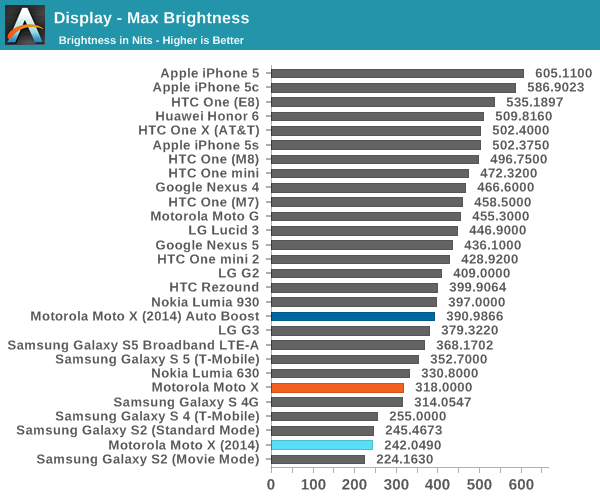
In the basics, the new Moto X is a bit on the low side. While AMOLED has traditionally struggled with luminance in situations such as the web browser and light-themed applications, Samsung’s Galaxy S5 and S5 LTE-A Broadband have shown that it’s possible to achieve levels of brightness approaching some of the brightest RGB-stripe LCDs. As the brightness of the Lumia 930 is about equal to the new Moto X, I suspect we're looking at the Galaxy S4/Note 3 generation of panels. This seems to be backed up by pictures of the subpixel layout seen below as the green subpixels seem to be noticeably larger when compared to the Galaxy S5's panel.
Contrast is still incredible, but I can still see the purple smearing effect that comes from unlit to lit pixels. I’m still unable to get a clear answer on why this is, but it’s likely that capacitance somewhere in the system is causing this issue in the form of RC delay. Whether this is a fixable issue is something I’m not aware of yet. The clear solution would be to set black to the lowest possible brightness a lit pixel can be, but this would make for worse contrast.

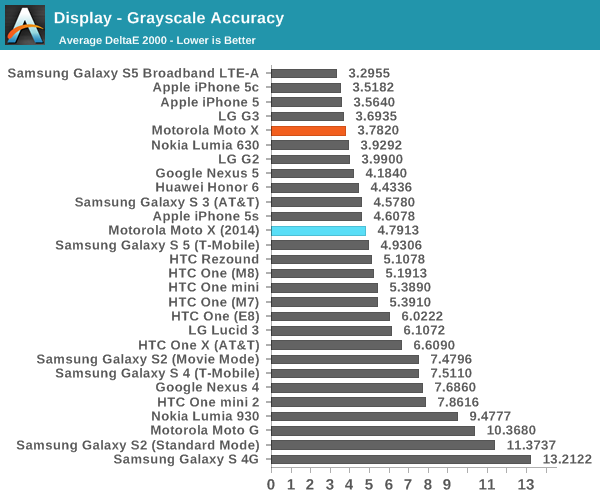
In grayscale, the new Moto X isn’t the best. We see that the display is just a bit too red, and that most of the luminance is coming from red and green. This makes sense from a power and display lifetime perspective though, as blue tends to have the least efficient emitter material in an AMOLED display. However, this translates to poor grayscale performance. The green tint tends to show itself in certain shades of grayscale as well.

In our saturation sweep, the new Moto X continues to be rather poor in its performance. While on Samsung phones it’s normal to see colors like this on the default display mode, there’s usually a mode that correctly constrains the display to sRGB which is the industry standard for displaying colors. There’s no such mode on the new Moto X, so the display significantly overshoots sRGB. This doesn’t bode well for the ColorChecker, which provides the most thorough look at color accuracy.
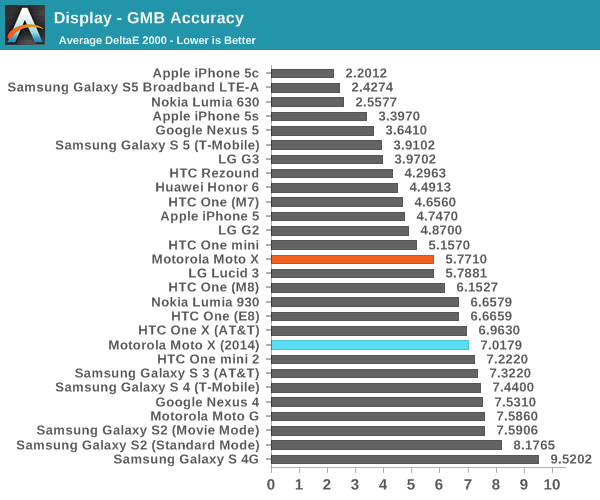
As predicted, the new Moto X does poorly in the ColorChecker. There’s really not much that the Moto X can accurately display in sRGB as just by pushing the gamut too far, even if there wasn’t saturation compression for some colors, the large gamut will cause distortion of all colors within the gamut triangle.
Unfortunately, it’s not clear where this lack of attention to color accuracy comes from. In discussions with Andrei it's clearly possible to calibrate the AMOLED panel from the GS4 quite accurately, and there's no real technical limitation for AMOLED to lack good calibration. However, judging by the relatively low peak brightness there are other issues as this could affect Motorola's performance in battery life tests. This seems to suggest that Motorola is unable to access the latest generation of AMOLED panels from Samsung Display.
This would be a rather startling thought, as it means that no matter what Motorola does to improve their implementation of Samsung’s AMOLED displays, they will always be behind the curve. If it becomes clear that Samsung’s AMOLED is the best display from a user-facing standpoint, every other OEM will face significant barriers in competition as they would be unable to access the latest generation AMOLED panels. The real solution here is for other display manufacturers such as LG, JDI, and AUO Optronics to catch up.
At any rate, the display of the new Moto X seems to be relatively poor compared to what we see in the Galaxy S5 LTE-A (and likely the Note 4), along with the iPhone 5s, Nexus 5, and One (M7). While it’s impossible to ignore the power advantage of AMOLED when implementing functions like Moto Display, the relatively low peak brightness and poor color accuracy are concerning.


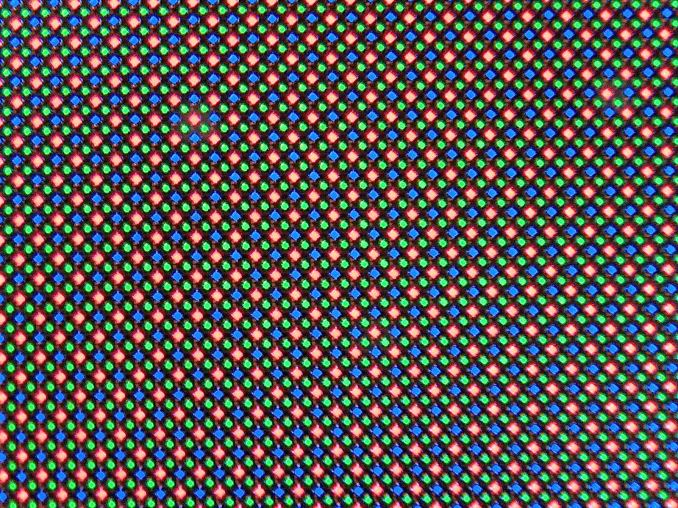

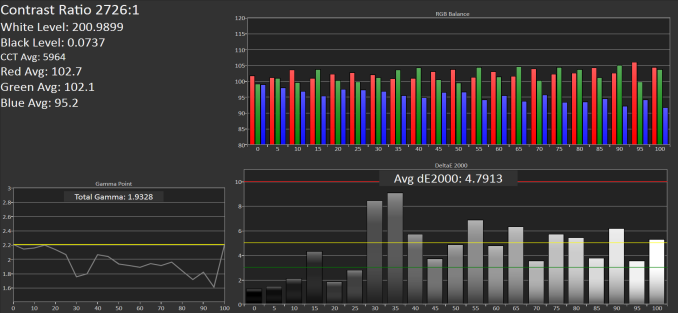

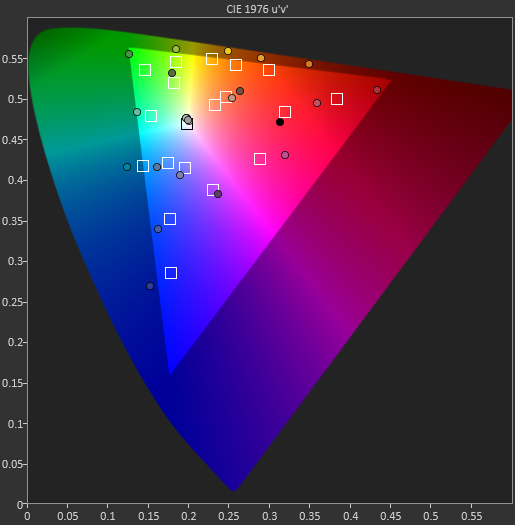








179 Comments
View All Comments
bigboxes - Wednesday, September 17, 2014 - link
For the most part I would agree that measurements should be given in inches. However, almost all manufacturing is done in metric and if I needed otherwise I would just use a conversion app on my smartphone. And for all the hater comments I'll await your cries the very next article that posts specs in inches. I know there are some foreign readers, but this is an American website so don't get too distraught when that happens. You can use that very same conversion app to convert inches to metric.Peroxyde - Wednesday, September 17, 2014 - link
I always respect AT audience as knowledgeable people. But this is the exception. Trust me on this one sir, the metric system is far superior. If you don't get it, this means there are some implications you are not aware of. This could be you are not strong in maths or science? Here is a simple test, do you know by heart each increment of the wrenches or drill bits sizes when measure in inches? With metric it goes by 1, 2, 3, ... even a 3 years old kid can know it without learning.nivedita - Wednesday, September 17, 2014 - link
Um, the US makes drill bits in fractions of an inch. You sound like a 3 yr old who just learned how to count yourself, you know.soccerballtux - Thursday, September 18, 2014 - link
inches will always be superior for size estimation. it's impossible to visualize how many centimeters a phone is by looking at it, because the count always exceeds 5. Inches, eh about 5, maybe 6. What, 13 centimeters? how am I supposed to visually divide the phone into 15 rows like I do with 5 inches? Just doesn't work, and won't ever. I, for one, think our socialist commie europeans can suck a fat 5" one.Peroxyde - Thursday, September 18, 2014 - link
Oh please, you don't know what you are talking about. You are blissfully happy to know that 1GB = 1000 MB, and you would scream in despair if you were told that a smartphone capacity has a 3/8 Giga inch bytes. When you start doing engineering calculation using feet, inch and pound you will understand what I meant.soccerballtux - Saturday, September 20, 2014 - link
I prefer mils myselftechxx - Wednesday, September 17, 2014 - link
I still think Motorola made the mistake of not realizing that the market wanted a BETTER Moto X, not a BIGGER one. If they had kept it at 4.7" and used a high quality display at 720p, we would have a very unique and incredible ergonomic phone that is high-spec'd with awesome battery life. My fingers are still crossed for a Moto X Compact that can deliver this because as of right now the Sony Xperia Z3 Compact is the true successor to the Moto X IMO.semo - Wednesday, September 17, 2014 - link
Or at the very least, they should have kept the Moto G the same size or bumped it to no further than 4.7". I think this is the only high end phone that doesn't have a SD slot. A removable battery is also a must as batteries are considered consumables. Like selling printers with sealed ink/toner cartridges. Madness!chrone - Wednesday, September 17, 2014 - link
+1. We want high performance 4.7" device.flyingpants1 - Wednesday, September 17, 2014 - link
It's called the Samsung Galaxy Alpha.